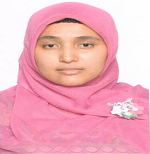Nur Rochmah
Airlangga University, Indonesia

Biography:
Nur Rochmah is working as a Lecturer of Department of Pediatrics, Faculty of Medicine, Airlangga University, Dr Soetomo Hospital. Surabaya. East Java. Indonesia
Abstract:
Background: Obesity in children are increasing rapidly lately. This may lead to insulin resistance and Diabetes Mellitus in adulthood. Acanthosis nigricans is manifestation of insulin resistance in the skin. The relationship between Acanthosis Nigricans(AN) and impaired glucose tolerance in overweight and obese children are still controversial.
Objective: To analyze relationship between acanthosis nigricans and impaired glucose tolerance in overweight and obese children.
Methods: This cross-sectional study was conducted between February until March 2017 in Pediatric endocrine outpatient clinic and Pediatric ward Dr. Soetomo Hospital. The presence of acanthosis nigricans was verified by Pediatric Endocrinology consultant, anthropometric and waist circumference measurements were taken. Oral glucose tolerance test was performed. Inclusion criterias were patient age 3-18 years old and BMI. Exclusion criterias were patient wih severe condition or in PICU and with congenital syndrome. Statistical analysis was using comparative study. Data analysis were performing using the SPSS 17.
Results: A total of 30 children were studied, 53.3% were boys, mean of age 10 year, mean of BMI 23.4, mean of waist circumference 87.6+/-12.8 cm. There were 21 patients had acanthosis nigricans and 14 with impaired glucose tolerance. Five obese children showed severe, seven with moderate and five with mild neck acanthosis nigricans respectively. Obese children were more likely to have acanthosis nigricans (P=0.019). There was significant correlation between acanthosis and impaired glucose tolerance (P=0.032).
Conclusion: There was relationship between acanthosis nigricans and impaired glucose tolerance in obese and overweight children.